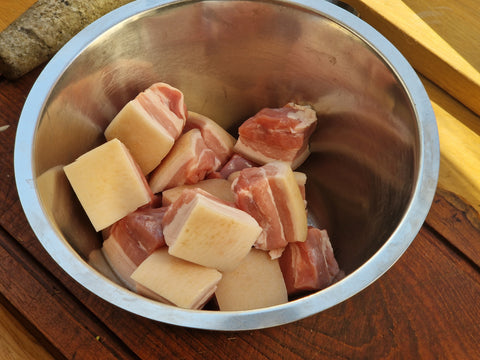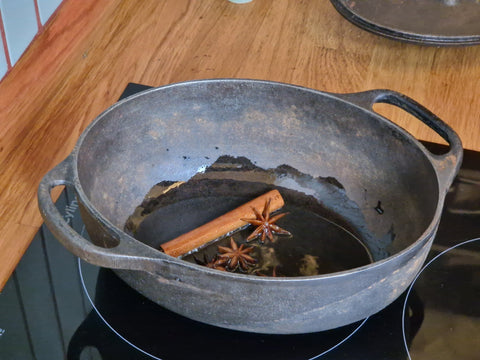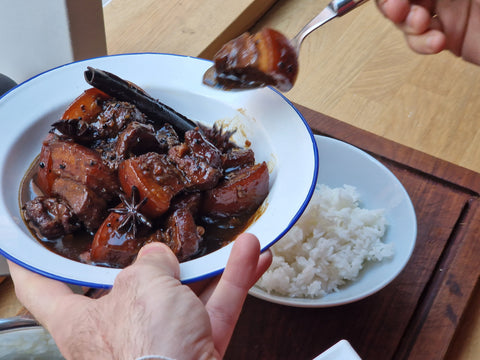หมูฮ้อง Moo Hong
Denna maträtt kommer från Phuket och närliggande områden i södra Thailand, som ursprungligen fördes till området av Hokkien-invandrare från Fujian, Kina någon gång på 1800-talet.
Det är en relativt enkel rätt jämfört med mycket av det thailändska köket, men är ljuvligt tröstande. Svartpeppar, vitlök och korianderrot ger en komplexitet och värme som kontrasterar med sötma och rikedom från kokossocker, mörk soja och fett fläsk.

Total tid 2-2½ timmar
Förberedelsetid 15 minuter
Tillagningstid 1½-2 timmar
Serverar 4 eller 6 om det äts till andra rätter
Ingredienser
- 8 vitlöksklyftor, skalade och grovt hackade
- 5 korianderrötter, rensade och grovhackade
- 1,5 msk hela svartpepparkorn
- ½ tsk flingsalt
- 3 msk kokossocker
- 2 msk thailändsk tunn sojasås
- 1 msk thailändsk svart sojasås
- 1 msk Shaoxing risvin (valfritt)
- 1 msk fläskfett eller matolja
- 1 kg fläskmage med skinn, inte för fet
- 5 hela stjärnanis
- 1 st kassiakanel
- 2 msk plockade korianderblad
Anteckningar
- Shaoxing-vinet är valfritt, gå inte ur ditt sätt att få detta.
- Thailändska sojasåser skiljer sig ganska mycket från kinesiska, men rätten kommer fortfarande att smaka bra om du ersätter kinesisk ljus soja och mörk soja med thailändsk tunna soja respektive svart soja. Använd inte japansk sojasås.
- Kokossocker används ofta nuförtiden, men brunt rörsocker skulle ursprungligen ha använts, så ersätt gärna muscovado eller något annat mörkt brunt socker.
- Korianderrötter köps lätt i asiatiska stormarknader, oftast fortfarande fästa vid stjälkarna. Du kan frysa det du inte använder. Om du inte hittar korianderrötter, lämna dem utanför – stjälkar är inget bra substitut.
- Moo Hong är utsökt på egen hand över ris, eller med lite wokade grönsaker, men som mest thailändsk mat är det bäst när det paras ihop med 2 eller 3 andra rätter, att ha en måltid som är balanserad i smaker.
Hur man
1. Skär fläskköttet i 4 cm tärningar.

2. Slå vitlök, korianderrot och pepparkorn med salt i en mortelstöt till en grov pasta. Det mesta av paprikan ska krossas, med bara några hela liktornar kvar. Alternativt blanda ingredienserna i en liten matberedare

3. Tillsätt denna pasta i en stor skål, tillsammans med fläsket, kokossockret, sojasåserna och risvinet. Massera in kryddorna i fläsket tills det är väl täckt.

4. Hetta upp en panna som är tillräckligt stor för att få plats med allt fläsk på medelvärme. När det är varmt, tillsätt fläskfettet eller oljan, stjärnanis och kanel. Stek kryddorna i en minut eller två tills de doftar.
 |
 |
5. Tillsätt det marinerade fläsket och fortsätt koka, rör om ofta, tills fläsket har helt ändrat färg och vitlöken och paprikan blir doftande.
6. Tillsätt tillräckligt med vatten för att nästan täcka fläsket, koka upp, sänk sedan värmen för att sjuda och koka i 1 ½ timme utan lock. 
7. Rör om grytan väl då och då. Det görs när fläskfettet är väldigt mjukt och skinnet kan skäras med en sked. Buljongen ska reduceras och tjocknas men inte sirapsliknande. Tillsätt lite vatten om det behövs längs vägen.
8. Servera på tallrik eller grund skål, skeda över buljongen och toppa med korianderbladen. Ät varmt, med jasminris.




